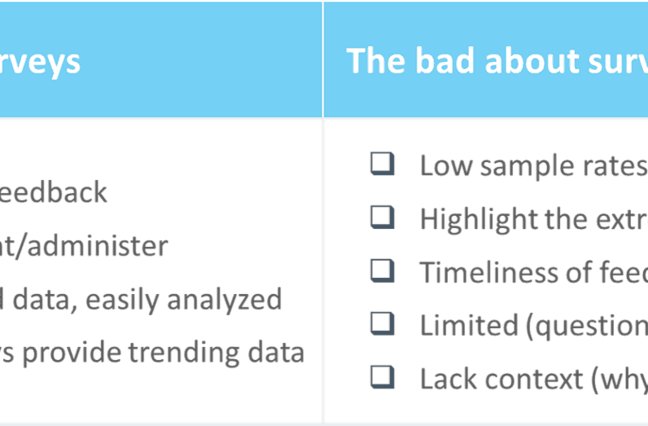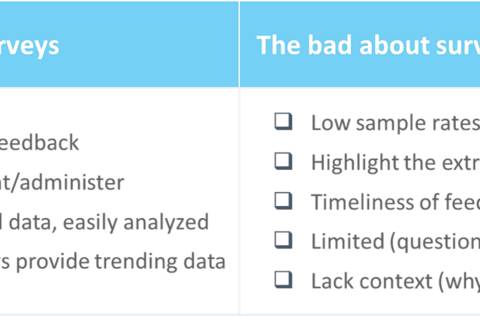CallMiner Product Innovation Series: Q2 2025
CallMiner's, Bruce McMahon, shares key product updates from Q2 2025. He looks at data privacy enhancements, CallMiner RealTime updates, the acquisitio...
March 12, 2019


Sentiment analysis has become an industry phrase that has ushered in an acute focus for organizations toward as both a necessity in business success and a core differentiator in customer experience. Sentiment analysis in the context of customer experience refers to gaining an understanding of how your customers feel about your products, promotions, brands, or the interactions they have with your organization such as through the contact center.
Traditionally customer feelings have been measured through use of surveys, what Gartner refers to as Direct Voice of the Customer. While asking for direct feedback is a critically important component of measuring customer sentiment, surveys do have several limitations, one being that they only collect feedback from the small percentage of customers that actually respond. The small sample of respondents usually represents a dichotomy of customer groups – the very happy, or the unhappy. The contact center or customer engagement center represents a huge repository of data, that if tapped, could give you a much broader view of your customers’ sentiment, with limitless ability to ask different questions of the data that you are already capturing every day.
According to Oxford Dictionaries Sentiment Analysis is: The process of computationally identifying and categorizing opinions expressed in a piece of text, especially in order to determine whether the writer’s attitude towards a particular topic, product, etc., is positive, negative, or neutral.
Of course with the advent of speech analytics, sentiment analysis is not limited only to written text, but can also be extracted from spoken word. Contact centers record an estimated nine million hours of calls per day in the United States alone. According to The CallMiner Index: Consumer Switching by Sector, the reasons and impact of call centers in the US and UK, 45% prefer voice for their preferred channel of engaging with organizations, more than double that of any other channel. And with voice, there is a treasure trove of opportunity to extract and analyze customer sentiment.
The best news is you don’t have to just conduct surveys in order to get at this data. While surveys do allow your customers to provide you direct feedback about how they feel, there are several key limitations to relying on surveys to understand customer sentiment through analyzing speech conversations or unsolicited feedback.
For starters, survey response rates are low. According to the American Customer Satisfaction Index, response rates to customer surveys range between 5 and 15%. This means that your analysis of customer attitude through surveys only represents a small portion of your customer base, and typically only the dissatisfied or extremely satisfied customers will take the time to respond. This won’t give you a true measure of customer sentiment towards your brand, products, or promotions. The short falls of sampling to collect feedback can be avoided by leveraging the already captured customer interactions to extract customer sentiment through analytics. You already have all the “responses” in your interaction archives, in data that is just waiting to be mined. Speech analytics (aka customer engagement analytics) will give you a better understanding across your customer base for how they feel towards various elements within your organization.
Surveys are also limited largely to the questions asked within the survey. To gather additional information, particularly if you need to dig into a particular reason for specific response, would require another survey, and the likelihood of getting the same respondents is slim to none. Surveys limit your ability to get context, or to be able to ask the “how” or “why” associated with the questions asked. Using interaction analytics to analyze your existing interactions allows you to return to the data over and over with additional questions. You have the ability to filter, target and dig in deep in certain areas as desired. Such analysis can even greatly inform what questions you should be asking when you do conduct a survey.
The last shortcoming of surveys is speed to intelligence, or lack thereof. In order to collect feedback, you have to determine the questions to ask, construct the survey, issue the survey, wait for responses, and then analyze the responses. Yes – analytics requires some of the same “setup” in terms of configuring the queries or searches to help ask the questions of the data you desire, but once configured, “responses” or insight can be gathered in near real-time as your customer engagement center continues to have interactions with your client base.
This is not to say you shouldn’t be surveying and collecting that direct feedback, but if you are only relying on surveys to understand your customers’ sentiment, you’re missing a big opportunity and may be making decisions based on limited data.
In order to measure your customers’ sentiment towards various topics with speech analytics, you need a sentiment model. Most sentiment models are black boxes, that look at your conversation and give you a rating. But let’s breakdown the anatomy of one approach to measuring sentiment.
First off you need to look for your customers’ expressions of positive or negative sentiment. You might also be able to look “neutral” sentiment or for simplicity, the absence of expressions of positive or negative sentiment is indicative of neutral sentiment. There are all kinds of sources of expressions of sentiment online, but simply put, positive expressions of sentiment would include various positive adjectives such as good, wonderful, awesome. Similarly, expressions of negative sentiment would be defined by list of negative descriptors such as bad, terrible, or awful.
Within the presence of what we’ll call either “intensifiers” or “inverters”, such expressions of sentiment can have varying degrees of positive or negative sentiment, or they may even have the opposite meaning. To state something is “bad” is not as condemning as it is to state something is “very bad”. And to state something is “not bad”, means the inverse, but likely doesn’t mean it is as good as saying it is “good”. If you think of sentiment as a score ranging from -10 to 10 you can see how various combinations of expressions of sentiment can range from having very high negative sentiment, through to neutral, through to very high positive sentiment, depending on the language used.
Engagement analytics is purpose built for looking for your customers’ use of certain language within their conversations or interactions with you. And some speech analytics software support sophisticated scoring models to allow for the creation of indices as described in the previous paragraph.
Having a sentiment model is only the start of the process. The next step is to not just get sentiment “as a whole”, but rather to apply that sentiment model to different parts of the conversation. Powerful analytics solutions allow you to conduct this type of query or questions of your data by essentially stitching together building blocks of queries that identify references to products or features, and positive or negative sentiment.
Enable instant insight from unstructured voice conversations from our intuitive interface and a flexible selection of scoring for action and intent. See how with Eureka Analyze.